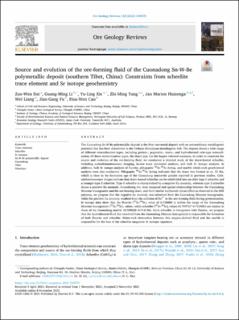Source and evolution of the ore-forming fluid of the Cuonadong Sn-W-Be polymetallic deposit (southern Tibet, China): constraints from scheelite trace element and Sr isotope geochemistry
Dai, Zuo-Wen; Li, Guang-Ming; Xie, Yu-Ling; Yang, Zhi-Ming; Huizenga, Jan Marten; Liang, Wei; Fu, Jian-Gang; Cao, Hua-Wen
Journal article, Peer reviewed
Published version
Permanent lenke
https://hdl.handle.net/11250/2981502Utgivelsesdato
2021Metadata
Vis full innførselSamlinger
Sammendrag
The Cuonadong Sn-W-Be polymetallic deposit is the first rare-metal deposit with an extraordinary metallogenic potential that has been discovered in the Tethyan Himalayan metallogenic belt. The deposit shows a wide range of different mineralization types, including greisen-, pegmatite-, skarn-, and hydrothermal vein-type mineralization. Of these mineralization types, the skarn-type has the largest inferred resources. In order to constrain the source and evolution of the ore-forming fluid, we conducted a detailed study of the skarn-hosted scheelite, including cathodoluminescence imaging, in-situ trace elemental analysis, and bulk Sr isotope analysis. In addition, bulk Sr isotope analysis of fluorite, phlogopite 40Ar-39Ar dating, and marble whole-rock geochemical analysis were also conducted. Phlogopite 40Ar-39Ar dating indicates that the skarn was formed at ca. 15 Ma, which is close to the formation age of the Cuonadong muscovite granite reported in previous studies. Cathodoluminescence images indicate that skarn-hosted scheelite can be subdivided into an older type 1 scheelite and a younger type 2 scheelite. Type 1 scheelite is characterized by a negative Eu anomaly, whereas type 2 scheelite shows a positive Eu anomaly. Considering the close temporal and spatial relationship between the Cuonadong Miocene leucogranite and the ore-bearing skarn, and their similar lanthanide tetrad effect as observed in the REE patterns, we propose that the negative Eu anomaly was inherited from the Cuonadong Miocene leucogranite, while the positive Eu anomaly resulted from the addition of Eu2+ to the ore-forming fluid during greisenization. Sr isotope data show that the fluorite (87Sr/86Sr)i value of 0.728885 is within the range of the Cuonadong Miocene leucogranite (87Sr/86Sr)i values, while scheelite (87Sr/86Sr)i values (0.709717-0.713480) are similar to those of the Cuonadong marble (0.709525-0.712146). Since scheelite is intergrown with fluorite, we propose that the hydrothermal fluid that exsolved from the Cuonadong Miocene leucogranite is responsible for formation of both fluorite and scheelite. Water-rock interaction between this magma-derived fluid and the marble is responsible for the loss of the scheelite magmatic Sr isotopic signature.
